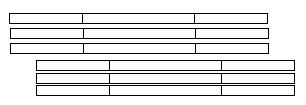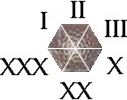Selection, splitting and staggering.
Step two
Straightening
Step threeBasic Beveling

m
 m fly rods
m fly rods
Heat treating
Step five Hand planing 1
Hand planing 2
Step sixHand planing 2
Gluing
Step sevenFinal dimensions
Step eightAttaching hardware
Step nineWrapping
Step tenFinish
Rod sock and tube
Step 12 Shipping and
Customer car
Next , the strips are staggered, so that the nodes are spaced evenly.
There are several ways to do this. two of the most common are the 3x3 stager and the 2x2x2 stager.

2x2x2 Stager
|

3x3 Stager
|
Spliting and adjusting the strips on the templet.
After getting the strips aligned on the
templet, I cut them to length. A tip strip for a 7ft 2p rod would
end up being appx 42" long. The length of the raw strips
would be 46" long. (3 inches of waste on each end I recomend at
least 3" of waste to allow for any miscalculation on down the line.)
 Next I mark the three pair of strips using Xs and Is. Each pair
is given a like number of Xs and Is and will end up across from each
other in the finished section. The first pair are marked X
and I, the second pair XX and II and the last pair are marked XXX and III
. The sequence that the strips will be glued is at left.
Next I mark the three pair of strips using Xs and Is. Each pair
is given a like number of Xs and Is and will end up across from each
other in the finished section. The first pair are marked X
and I, the second pair XX and II and the last pair are marked XXX and III
. The sequence that the strips will be glued is at left.
 Next I mark the three pair of strips using Xs and Is. Each pair
is given a like number of Xs and Is and will end up across from each
other in the finished section. The first pair are marked X
and I, the second pair XX and II and the last pair are marked XXX and III
. The sequence that the strips will be glued is at left.
Next I mark the three pair of strips using Xs and Is. Each pair
is given a like number of Xs and Is and will end up across from each
other in the finished section. The first pair are marked X
and I, the second pair XX and II and the last pair are marked XXX and III
. The sequence that the strips will be glued is at left.